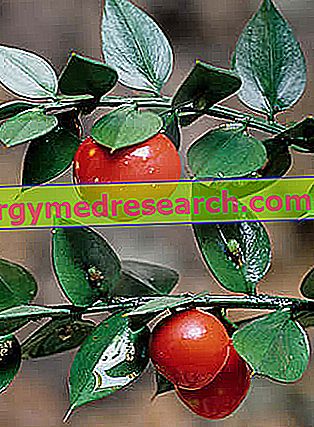Premise
Depending on the context in which the term is used, the melon refers to both the plant and the fruit; known for its imposing size, orange color, very sweet taste and freshness, melon, together with watermelon, has become the emblem of summer.
Origins and diffusion
The origin of the melons is still debated and uncertain: if many authors are convinced that this fruit originates from Asia, so many consider Africa as its true country of origin. However, what is certain is that currently Asian countries - China in particular - are the world's largest melon producers.
At present, the cultivation of the melon is practically widespread all over the world: in our country as many as 23, 000 hectares are destined to plantations of this fruit.

Botanical analysis of the melon
In botany, the melon is better known as Cucumis melo, belonging to the Curcubitaceae family. It is an annual plant, whose main stem, generally creeping, can branch and therefore become a climber: in this case, the plant needs support.
The leaves of the melon plant are lobed, reniform and rounded, while the roots appear to be very developed both in depth and on the surface.
The fruit melon is a peponide with a fleshy, juicy and very sweet orange-yellow pulp: the fruit is clearly distinguishable due to its imposing size and rather important weight (from 0.4 to 4 kg). The melon consists of a rather hard and massive peel (epicarp), a pulpy and juicy mesocarp (pulp), while inside are the seeds set in a rather spongy, fibrous and soggy mass.
The seeds, very numerous, are soft, generally white and pointed only at one end (teardrop shape) [from //www.agraria.org/]
Variety and types
First of all there is a first distinction of melons, depending on food consumption: there are melons "fruit" and melons "vegetable".
Clearly, the melons intended as fruit are the most well-known, sweet, typically summer and harvested at full maturity: in this category, in turn, we distinguish reticulated melons (or retati, with white or yellowish pulp), inodorus type (melon in winter, with white or pinkish flesh and smooth skin) and cantaloupe melons (with smooth pericarp and typically orange flesh).
Among the "fruit" varieties, the yellow melons stand out, easily distinguishable by the typically yellowish pulp and by the white and smooth pericarp.
"Vegetable" melons are harvested before ripening: there are bitter melons ( momordica group), exploited for their medicinal properties, because they are mines of antioxidant vitamins, snake or tortarello melons, used in salads such as cucumbers.
Winter melon

Among the most well-known winter varieties the Naples giant, characterized by a thin, greenish skin and a particularly sweet white pulp, cannot be missed.
The Morettino melon also stands out, with its dark green skin and whitish flesh.
The melon of Malta instead has a very special green pulp.
However, lovers of summer melon can somehow preserve its load of flavor for the winter months by preparing melon jam at home.
Store the melons
The summer melons must be kept in the fridge, at a temperature not lower than 5 ° C: in fact, when it falls below this threshold, the fruit suffers, forming red spots in the pulp, responsible for softening it.
When the melon is not ripe, it is preferable to store it at room temperature, in order to accelerate the maturation processes.
The quality of the melon can be recognized both to the touch and the scent: to the touch, the melon must not be soft, since it could be acidic and unpleasant, while the strong and intense perfume is emanated from the peel and is a sign of maturity of the fruit .
Nutritional analysis
We now come to the most interesting part of the melon: nutritional analysis. As is known, the melon is among the sweetest and at the same time thirst-quenching fruits: sometimes, the sugar component exceeds 13%, (below 10-11% of sugars, the melon is sometimes called poor quality ).
The quantity of water contained in it often exceeds 90%; in the composition of the melon we also remember a minimal amount of fibers, proteins and fats (each of which can be found below 1%).
Despite the large quantity of sugar, the melon is a food friend of low-calorie diets, thanks to the reduced caloric intake: 100 grams of food make, in fact, only 33 kcal.
The melon is very rich in vitamins and mineral salts: among the vitamins, it is worth to mention A (189mg / 100g of product), C (37mg / 100g of melon), PP (0.6mg / 100g of fruit) and traces of vitamin B1 and B2.
Melon is a source of potassium, calculated around 333 mg per 100 grams of product; also the quantity of phosphorus (13 mg / 100 g of melon), calcium and sodium (8 mg / 100 g of product) is conspicuous.
Melon: property
In the past, the consumption of melons was not recommended because the belief that this fruit could "diminish the genital seed" was in vogue; still, at that time, there were those who considered the melon a harmful fruit, imputed for the death of some emperors.
Currently, the consumption of melons is not recommended only for diabetics and all people who complain of gastric disorders, such as acidity and digestive difficulties: certainly, the melon is not harmful, nor does it diminish the genital seed!
Given the large amount of vitamin A and C, the melon is one of the strong antioxidant foods: in this regard, it is recommended for sun lovers, considering however that the melon stimulates the production of melanin, favoring tanning and protecting the skin from solar radiation.
It is also believed that the melon plays an important role in enhancing the visual capacity (due to the presence of beta-carotene), as well as being an important aid in strengthening teeth and bones.
In folk medicine, melon is considered an excellent depurative, diuretic and refreshing; furthermore, in the form of compresses, it is particularly indicated for treating burns and burns (soothing properties).
Ham and melon
The typical, as well as very tasty, combination of ham and melon, in addition to making the melons more tasty - so to speak - weak, is an expedient to make them more digestible and less laxative (property due to the generous presence of fibers and simple sugars) .
In this video we offer you an exquisite (and beautiful) summer salad made with ham, melon and shrimp, because the eye wants its part too! First, however, make sure you get the right manual skills in cleaning and cutting the melon.
Summer salad with ham, melon and prawns
X Problems with video playback? Reload from YouTube Go to Video Page Go to Video Recipes Section Watch the video on youtubeMelon in brief, Summary on melon properties »



